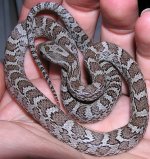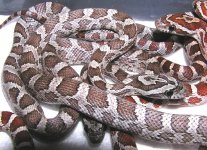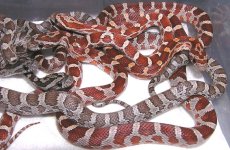HELP!!! Alrighty I can't wait for my genetics book to get here, it is taking so long! When I breed these projects animals together (all are full siblings) I get two types of "Anery C's". I get high saddle count and normals saddle count.
Below are pics...
The first one.... a high saddle count, the second two.... normal saddle count.
The last pic is just a purdy pic of some siblings.
I have two female breeders in this project, VHead and FTwin. I also have two males, Mamma's Boy and MTwin.
Last year when I bred VHead and Mama's Boy I got the high saddle count types, this year when I bred VHead to MTwin, I got normal saddle count types. This was FTwins first year of breeding and when bred to Mamma's Boy, she also produced high saddle counts.
Up until now, it has been all or nothing, either all the anery hatchlings have high saddle count, or all of them have normal saddle count. And in clutches when I get high saddle counts, only the Anery C's in the clutch have the high count. This year I bred Mamma's Boy back to his mother (how ironic) and I got 2 high saddle count Anery C's and one normal count Anery C. :shrugs:
Any of you super smart people have a clue what is going on? Is this behaving like a Simple Recessive that only displays in an Anery C?? I'm so confused.
Below are pics...
The first one.... a high saddle count, the second two.... normal saddle count.
The last pic is just a purdy pic of some siblings.
I have two female breeders in this project, VHead and FTwin. I also have two males, Mamma's Boy and MTwin.
Last year when I bred VHead and Mama's Boy I got the high saddle count types, this year when I bred VHead to MTwin, I got normal saddle count types. This was FTwins first year of breeding and when bred to Mamma's Boy, she also produced high saddle counts.
Up until now, it has been all or nothing, either all the anery hatchlings have high saddle count, or all of them have normal saddle count. And in clutches when I get high saddle counts, only the Anery C's in the clutch have the high count. This year I bred Mamma's Boy back to his mother (how ironic) and I got 2 high saddle count Anery C's and one normal count Anery C. :shrugs:
Any of you super smart people have a clue what is going on? Is this behaving like a Simple Recessive that only displays in an Anery C?? I'm so confused.



